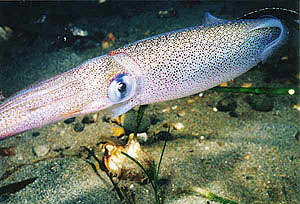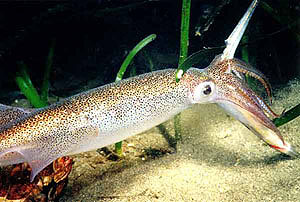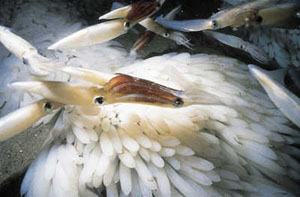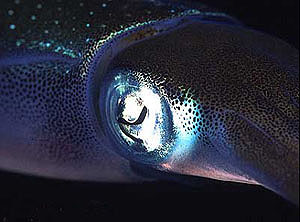
Loligo opalescens. Photo: Jon and Keith, www.seaotter.com.
 Loligo opalescens. Photo: Jon and Keith, www.seaotter.com. |
There are squids of various sizes, from the 30 cm Loligo vulgaris from the Mediterranean up to the giant squid, whose size we only can guess, estimates being as large as 20 metres.
Like cuttlefish (Sepia) the squids (Loligo) are part of the ten arm cephalopods (Decabrachia). So squids have eight short arms around the mouth and two longer tentacles broadened at the end to form a club-like structure armed with suckers.
A squid's rear body is shaped like a torpedo. At its tail end there are two larger or smaller fins serving for locomotion and changing its direction.
Mainly squids' locomotion, however, is by another method. Squids are the fighter jets among the cephalopods. Driven by the cephalopods' well known propulsion by pressing water from their pallial cavity, squids move backwards through the water like a rocket. Squids almost exclusively move that way. The jet's direction (and thus the direction of the movement) can be changed by altering the siphon's angle.
Squids live in the pelagic - the open sea. At least the small squid species, like the common squid (Loligo vulgaris) swim through the open sea in swarms. Besides protection by swimming in the swarm, squids also sink to the ground and hide there when attacked.
 Loligo opalescens. Photo: Jon and Keith, www.seaotter.com. |
Squids are fast hunters, catching their prey while swimming. The prey is caught with the club-like end of the long tentacles and then pulled towards the mouth, supported with the short arms. The strong beak cuts the prey in parts and the rasp tongue or radula is used to process the food into smaller parts. All molluscs (except those that do not have a head, such as mussels) have this organ, which also is exceptional to the mollusc phylum. Besides fish squids' prey are other molluscs as well as crustaceans.
On the other hand, squids are favourite prey to many fish species, as well as to many whales. The giant squids are hunted by sperm whales (Physeter macrocephalus). Last, but not least, squids are also eaten by man. They are fished from the sea in large amounts with nets.
 Mating squids in front of large amounts of egg packets. Source: calacademy.org. |
Squids usually mate in swarms. To do so the common squid wanders into special areas at the North Sea coast like a migratory bird. At other times it lives in the open sea of the Mediterranean, the Atlantic Ocean, as well as North and Baltic Sea. After mating the eggs are laid in large jelly packets.
Squids have got a highly developed nervous system, presumably the result of a concurrent evolution of squids and fish being prey as well as hunters. The skin colour of squids can be changed by nervous impulses to single colour cells (chromatophores). The swarm-living squids probably also communicate by changing colours. Besides, like other cephalopods, squids also use their colour for camouflage.
 Sepioteuthis sepioidea. Photo: Phil Slosberg. |
Besides some squid species possess illumination organs (photophores), which can be employed to distract enemies, but also to attract prey.
Compared to the overall body squids' eyes are strikingly large. In relation to the size of their body squids have the largest eyes in the animal kingdom. A 10 metre giant squid's eye is as large as a soup plate.
By the construction of their eyes squids are divided into myopsid (Loliginoidea or Myopsida) and oegopsid (Architeuthoidea or Oegopsida) squids, The eyes of the Myopsida, the common squid (Loligo vulgaris) is part of, is covered by a tissue layer. Giant squids (Architeuthis), however, belong to the Oegopsida, their eye is "naked".
Outside of malacology (the science of molluscs) squids are well known because of their giant axons. Whereas the largest human axon reaches a size of 0,02 mm, squids' axons may reach up to 2 mm diameter. Because their axons can be examined much more easily than other animals' nervous cells is why squids are especially valuable to neurobiology.